A Critical Report on PepsiCo's Future Challenges in Global Business
VerifiedAdded on 2023/06/11
|12
|4673
|442
Report
AI Summary
This report identifies potential future challenges for PepsiCo in the global business environment, covering cultural, political, legal, economic, technological, competitive, physical, natural, and demographic factors. It examines the impact of international trade theories, such as the international product lifecycle and comparative advantage, on PepsiCo's strategies. The report further discusses the influence of business-government trade relations, foreign direct investment, and regional economic integration on the company. Finally, it explores how PepsiCo manipulates international financial markets and the international monetary system for competitive advantage. The document is available on Desklib, a platform offering a range of study resources for students.

qwertyuiopasdfghjklzxcvbnmqw
ertyuiopasdfghjklzxcvbnmqwert
yuiopasdfghjklzxcvbnmqwertyui
opasdfghjklzxcvbnmqwertyuiopa
sdfghjklzxcvbnmqwertyuiopasdf
ghjklzxcvbnmqwertyuiopasdfghj
klzxcvbnmqwertyuiopasdfghjklz
xcvbnmqwertyuiopasdfghjklzxcv
bnmqwertyuiopasdfghjklzxcvbn
mqwertyuiopasdfghjklzxcvbnmq
wertyuiopasdfghjklzxcvbnmqwer
tyuiopasdfghjklzxcvbnmqwertyui
opasdfghjklzxcvbnmqwertyuiopa
sdfghjklzxcvbnmqwertyuiopasdf
ghjklzxcvbnmqwertyuiopasdfghj
klzxcvbnmqwertyuiopasdfghjklz
xcvbnmrtyuiopasdfghjklzxcvbnm
qwertyuiopasdfghjklzxcvbnmqw
International business
ertyuiopasdfghjklzxcvbnmqwert
yuiopasdfghjklzxcvbnmqwertyui
opasdfghjklzxcvbnmqwertyuiopa
sdfghjklzxcvbnmqwertyuiopasdf
ghjklzxcvbnmqwertyuiopasdfghj
klzxcvbnmqwertyuiopasdfghjklz
xcvbnmqwertyuiopasdfghjklzxcv
bnmqwertyuiopasdfghjklzxcvbn
mqwertyuiopasdfghjklzxcvbnmq
wertyuiopasdfghjklzxcvbnmqwer
tyuiopasdfghjklzxcvbnmqwertyui
opasdfghjklzxcvbnmqwertyuiopa
sdfghjklzxcvbnmqwertyuiopasdf
ghjklzxcvbnmqwertyuiopasdfghj
klzxcvbnmqwertyuiopasdfghjklz
xcvbnmrtyuiopasdfghjklzxcvbnm
qwertyuiopasdfghjklzxcvbnmqw
International business
Paraphrase This Document
Need a fresh take? Get an instant paraphrase of this document with our AI Paraphraser
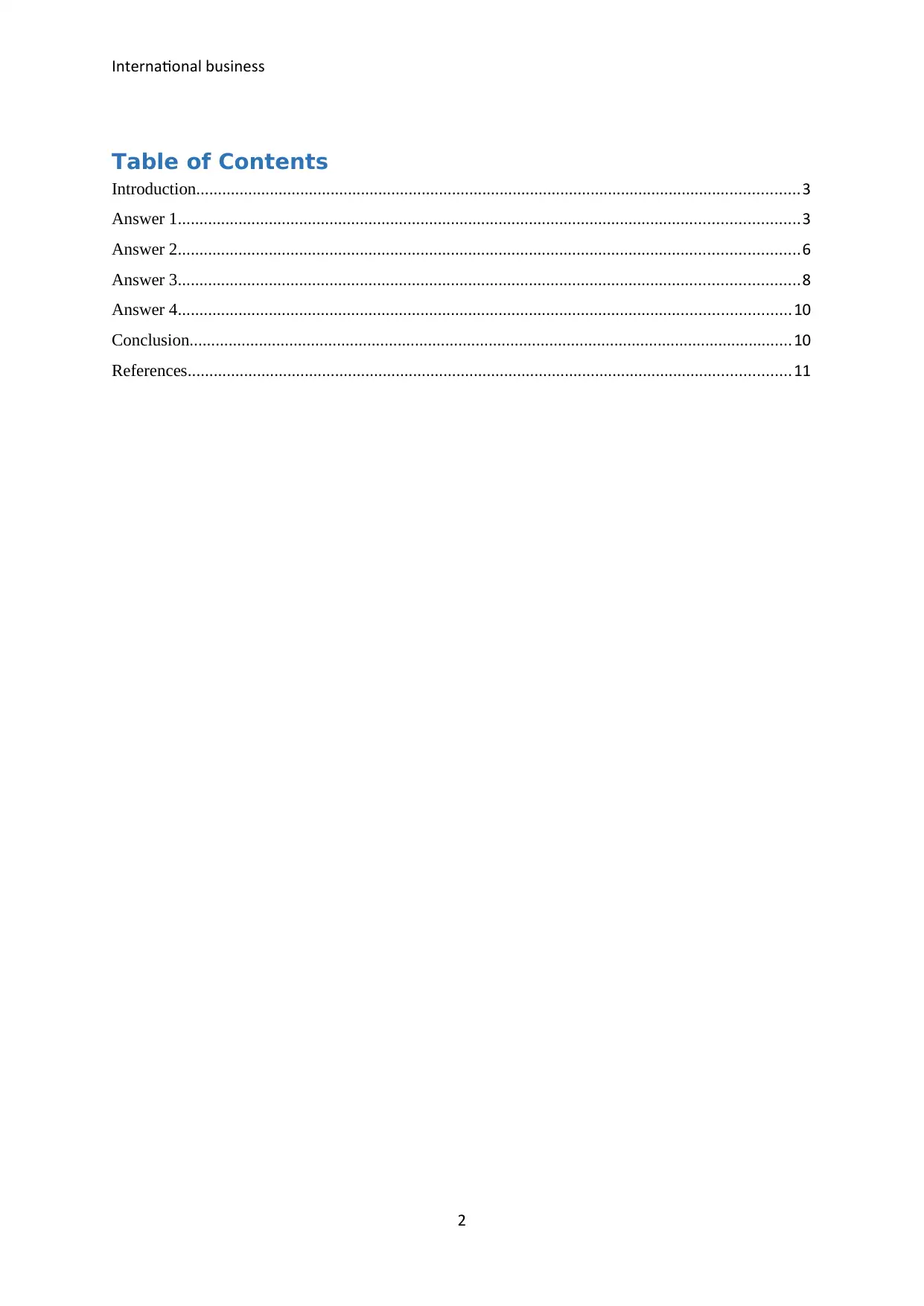
International business
Table of Contents
Introduction...........................................................................................................................................3
Answer 1...............................................................................................................................................3
Answer 2...............................................................................................................................................6
Answer 3...............................................................................................................................................8
Answer 4.............................................................................................................................................10
Conclusion...........................................................................................................................................10
References...........................................................................................................................................11
2
Table of Contents
Introduction...........................................................................................................................................3
Answer 1...............................................................................................................................................3
Answer 2...............................................................................................................................................6
Answer 3...............................................................................................................................................8
Answer 4.............................................................................................................................................10
Conclusion...........................................................................................................................................10
References...........................................................................................................................................11
2
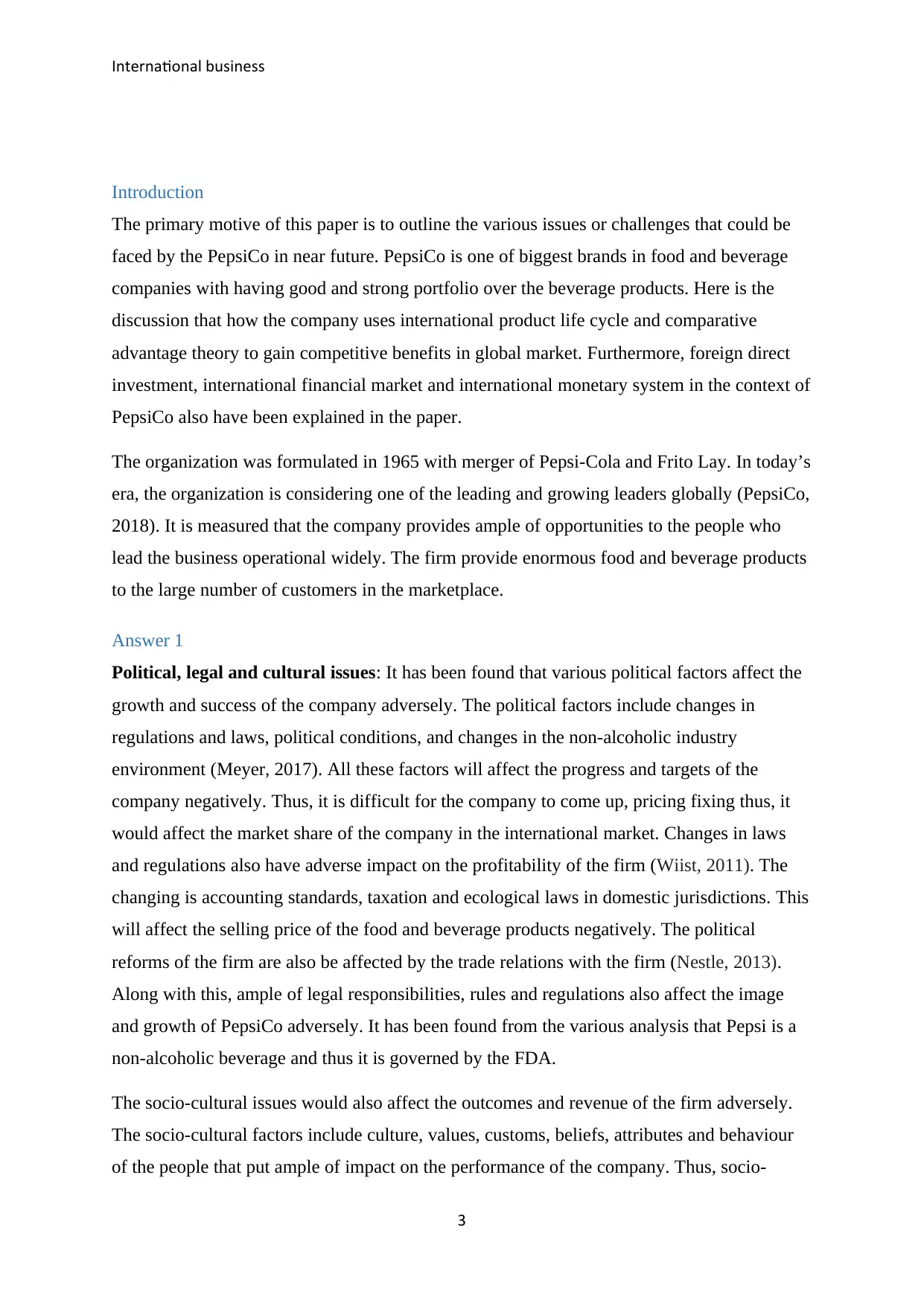
International business
Introduction
The primary motive of this paper is to outline the various issues or challenges that could be
faced by the PepsiCo in near future. PepsiCo is one of biggest brands in food and beverage
companies with having good and strong portfolio over the beverage products. Here is the
discussion that how the company uses international product life cycle and comparative
advantage theory to gain competitive benefits in global market. Furthermore, foreign direct
investment, international financial market and international monetary system in the context of
PepsiCo also have been explained in the paper.
The organization was formulated in 1965 with merger of Pepsi-Cola and Frito Lay. In today’s
era, the organization is considering one of the leading and growing leaders globally (PepsiCo,
2018). It is measured that the company provides ample of opportunities to the people who
lead the business operational widely. The firm provide enormous food and beverage products
to the large number of customers in the marketplace.
Answer 1
Political, legal and cultural issues: It has been found that various political factors affect the
growth and success of the company adversely. The political factors include changes in
regulations and laws, political conditions, and changes in the non-alcoholic industry
environment (Meyer, 2017). All these factors will affect the progress and targets of the
company negatively. Thus, it is difficult for the company to come up, pricing fixing thus, it
would affect the market share of the company in the international market. Changes in laws
and regulations also have adverse impact on the profitability of the firm (Wiist, 2011). The
changing is accounting standards, taxation and ecological laws in domestic jurisdictions. This
will affect the selling price of the food and beverage products negatively. The political
reforms of the firm are also be affected by the trade relations with the firm (Nestle, 2013).
Along with this, ample of legal responsibilities, rules and regulations also affect the image
and growth of PepsiCo adversely. It has been found from the various analysis that Pepsi is a
non-alcoholic beverage and thus it is governed by the FDA.
The socio-cultural issues would also affect the outcomes and revenue of the firm adversely.
The socio-cultural factors include culture, values, customs, beliefs, attributes and behaviour
of the people that put ample of impact on the performance of the company. Thus, socio-
3
Introduction
The primary motive of this paper is to outline the various issues or challenges that could be
faced by the PepsiCo in near future. PepsiCo is one of biggest brands in food and beverage
companies with having good and strong portfolio over the beverage products. Here is the
discussion that how the company uses international product life cycle and comparative
advantage theory to gain competitive benefits in global market. Furthermore, foreign direct
investment, international financial market and international monetary system in the context of
PepsiCo also have been explained in the paper.
The organization was formulated in 1965 with merger of Pepsi-Cola and Frito Lay. In today’s
era, the organization is considering one of the leading and growing leaders globally (PepsiCo,
2018). It is measured that the company provides ample of opportunities to the people who
lead the business operational widely. The firm provide enormous food and beverage products
to the large number of customers in the marketplace.
Answer 1
Political, legal and cultural issues: It has been found that various political factors affect the
growth and success of the company adversely. The political factors include changes in
regulations and laws, political conditions, and changes in the non-alcoholic industry
environment (Meyer, 2017). All these factors will affect the progress and targets of the
company negatively. Thus, it is difficult for the company to come up, pricing fixing thus, it
would affect the market share of the company in the international market. Changes in laws
and regulations also have adverse impact on the profitability of the firm (Wiist, 2011). The
changing is accounting standards, taxation and ecological laws in domestic jurisdictions. This
will affect the selling price of the food and beverage products negatively. The political
reforms of the firm are also be affected by the trade relations with the firm (Nestle, 2013).
Along with this, ample of legal responsibilities, rules and regulations also affect the image
and growth of PepsiCo adversely. It has been found from the various analysis that Pepsi is a
non-alcoholic beverage and thus it is governed by the FDA.
The socio-cultural issues would also affect the outcomes and revenue of the firm adversely.
The socio-cultural factors include culture, values, customs, beliefs, attributes and behaviour
of the people that put ample of impact on the performance of the company. Thus, socio-
3
⊘ This is a preview!⊘
Do you want full access?
Subscribe today to unlock all pages.

Trusted by 1+ million students worldwide
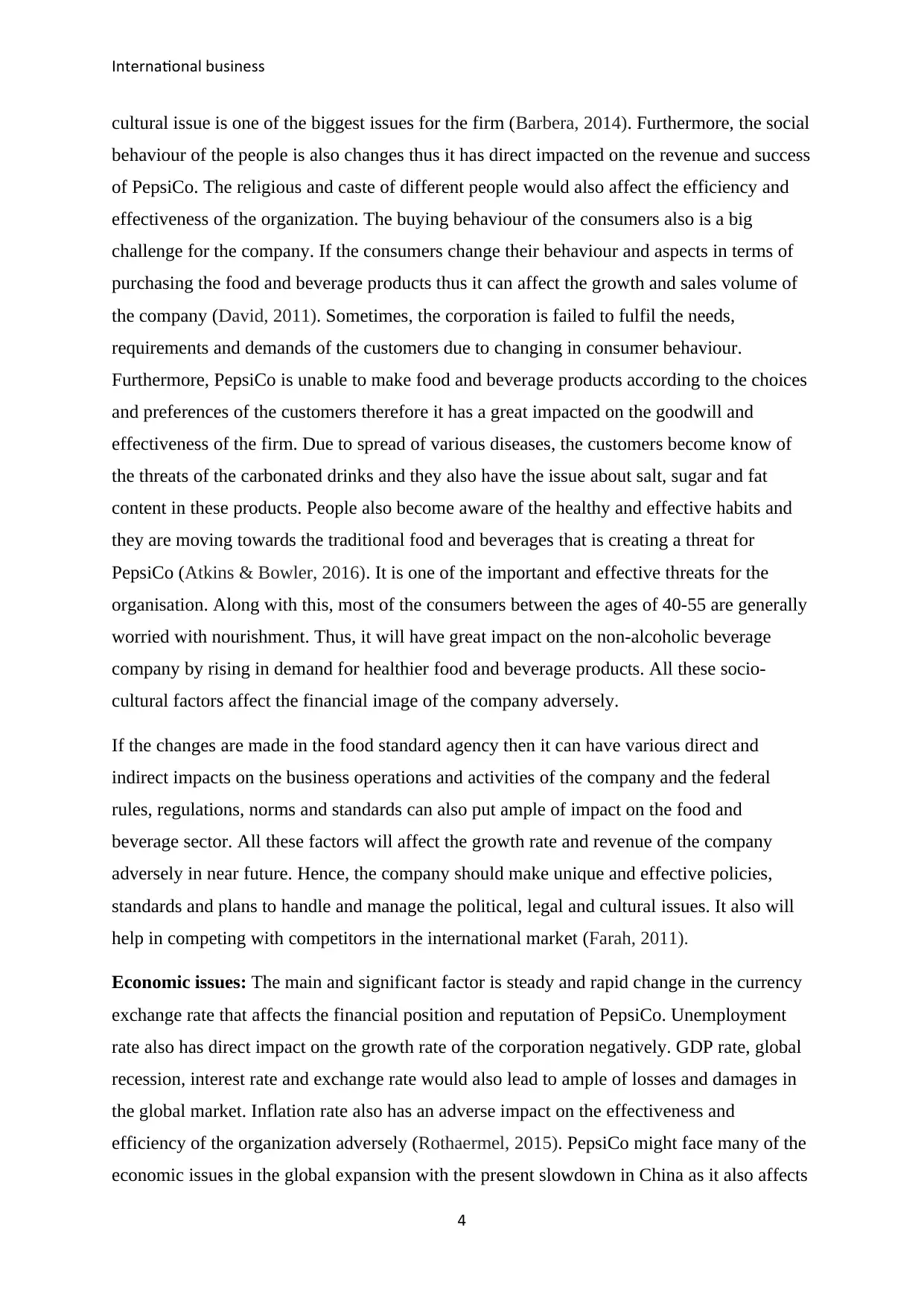
International business
cultural issue is one of the biggest issues for the firm (Barbera, 2014). Furthermore, the social
behaviour of the people is also changes thus it has direct impacted on the revenue and success
of PepsiCo. The religious and caste of different people would also affect the efficiency and
effectiveness of the organization. The buying behaviour of the consumers also is a big
challenge for the company. If the consumers change their behaviour and aspects in terms of
purchasing the food and beverage products thus it can affect the growth and sales volume of
the company (David, 2011). Sometimes, the corporation is failed to fulfil the needs,
requirements and demands of the customers due to changing in consumer behaviour.
Furthermore, PepsiCo is unable to make food and beverage products according to the choices
and preferences of the customers therefore it has a great impacted on the goodwill and
effectiveness of the firm. Due to spread of various diseases, the customers become know of
the threats of the carbonated drinks and they also have the issue about salt, sugar and fat
content in these products. People also become aware of the healthy and effective habits and
they are moving towards the traditional food and beverages that is creating a threat for
PepsiCo (Atkins & Bowler, 2016). It is one of the important and effective threats for the
organisation. Along with this, most of the consumers between the ages of 40-55 are generally
worried with nourishment. Thus, it will have great impact on the non-alcoholic beverage
company by rising in demand for healthier food and beverage products. All these socio-
cultural factors affect the financial image of the company adversely.
If the changes are made in the food standard agency then it can have various direct and
indirect impacts on the business operations and activities of the company and the federal
rules, regulations, norms and standards can also put ample of impact on the food and
beverage sector. All these factors will affect the growth rate and revenue of the company
adversely in near future. Hence, the company should make unique and effective policies,
standards and plans to handle and manage the political, legal and cultural issues. It also will
help in competing with competitors in the international market (Farah, 2011).
Economic issues: The main and significant factor is steady and rapid change in the currency
exchange rate that affects the financial position and reputation of PepsiCo. Unemployment
rate also has direct impact on the growth rate of the corporation negatively. GDP rate, global
recession, interest rate and exchange rate would also lead to ample of losses and damages in
the global market. Inflation rate also has an adverse impact on the effectiveness and
efficiency of the organization adversely (Rothaermel, 2015). PepsiCo might face many of the
economic issues in the global expansion with the present slowdown in China as it also affects
4
cultural issue is one of the biggest issues for the firm (Barbera, 2014). Furthermore, the social
behaviour of the people is also changes thus it has direct impacted on the revenue and success
of PepsiCo. The religious and caste of different people would also affect the efficiency and
effectiveness of the organization. The buying behaviour of the consumers also is a big
challenge for the company. If the consumers change their behaviour and aspects in terms of
purchasing the food and beverage products thus it can affect the growth and sales volume of
the company (David, 2011). Sometimes, the corporation is failed to fulfil the needs,
requirements and demands of the customers due to changing in consumer behaviour.
Furthermore, PepsiCo is unable to make food and beverage products according to the choices
and preferences of the customers therefore it has a great impacted on the goodwill and
effectiveness of the firm. Due to spread of various diseases, the customers become know of
the threats of the carbonated drinks and they also have the issue about salt, sugar and fat
content in these products. People also become aware of the healthy and effective habits and
they are moving towards the traditional food and beverages that is creating a threat for
PepsiCo (Atkins & Bowler, 2016). It is one of the important and effective threats for the
organisation. Along with this, most of the consumers between the ages of 40-55 are generally
worried with nourishment. Thus, it will have great impact on the non-alcoholic beverage
company by rising in demand for healthier food and beverage products. All these socio-
cultural factors affect the financial image of the company adversely.
If the changes are made in the food standard agency then it can have various direct and
indirect impacts on the business operations and activities of the company and the federal
rules, regulations, norms and standards can also put ample of impact on the food and
beverage sector. All these factors will affect the growth rate and revenue of the company
adversely in near future. Hence, the company should make unique and effective policies,
standards and plans to handle and manage the political, legal and cultural issues. It also will
help in competing with competitors in the international market (Farah, 2011).
Economic issues: The main and significant factor is steady and rapid change in the currency
exchange rate that affects the financial position and reputation of PepsiCo. Unemployment
rate also has direct impact on the growth rate of the corporation negatively. GDP rate, global
recession, interest rate and exchange rate would also lead to ample of losses and damages in
the global market. Inflation rate also has an adverse impact on the effectiveness and
efficiency of the organization adversely (Rothaermel, 2015). PepsiCo might face many of the
economic issues in the global expansion with the present slowdown in China as it also affects
4
Paraphrase This Document
Need a fresh take? Get an instant paraphrase of this document with our AI Paraphraser
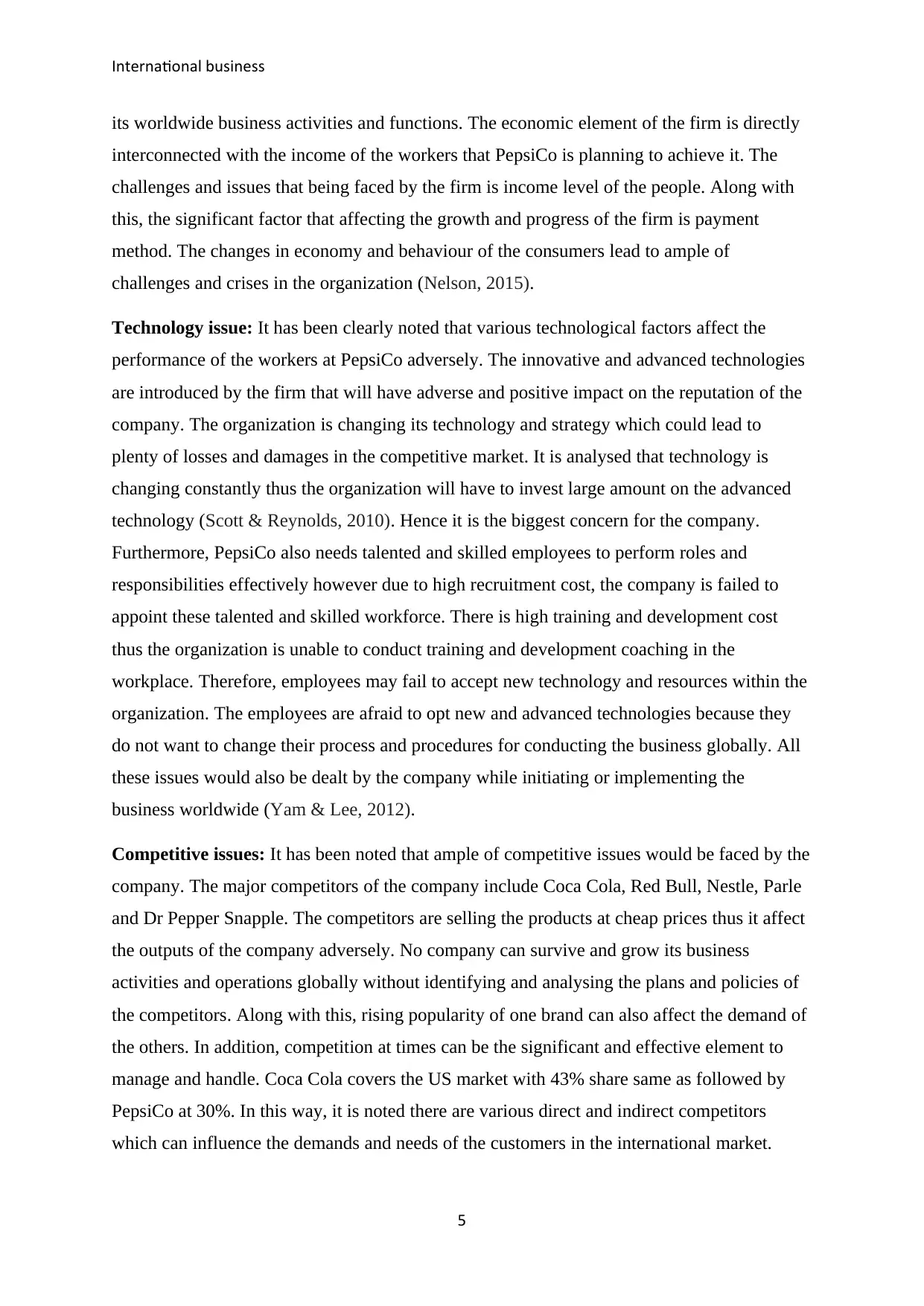
International business
its worldwide business activities and functions. The economic element of the firm is directly
interconnected with the income of the workers that PepsiCo is planning to achieve it. The
challenges and issues that being faced by the firm is income level of the people. Along with
this, the significant factor that affecting the growth and progress of the firm is payment
method. The changes in economy and behaviour of the consumers lead to ample of
challenges and crises in the organization (Nelson, 2015).
Technology issue: It has been clearly noted that various technological factors affect the
performance of the workers at PepsiCo adversely. The innovative and advanced technologies
are introduced by the firm that will have adverse and positive impact on the reputation of the
company. The organization is changing its technology and strategy which could lead to
plenty of losses and damages in the competitive market. It is analysed that technology is
changing constantly thus the organization will have to invest large amount on the advanced
technology (Scott & Reynolds, 2010). Hence it is the biggest concern for the company.
Furthermore, PepsiCo also needs talented and skilled employees to perform roles and
responsibilities effectively however due to high recruitment cost, the company is failed to
appoint these talented and skilled workforce. There is high training and development cost
thus the organization is unable to conduct training and development coaching in the
workplace. Therefore, employees may fail to accept new technology and resources within the
organization. The employees are afraid to opt new and advanced technologies because they
do not want to change their process and procedures for conducting the business globally. All
these issues would also be dealt by the company while initiating or implementing the
business worldwide (Yam & Lee, 2012).
Competitive issues: It has been noted that ample of competitive issues would be faced by the
company. The major competitors of the company include Coca Cola, Red Bull, Nestle, Parle
and Dr Pepper Snapple. The competitors are selling the products at cheap prices thus it affect
the outputs of the company adversely. No company can survive and grow its business
activities and operations globally without identifying and analysing the plans and policies of
the competitors. Along with this, rising popularity of one brand can also affect the demand of
the others. In addition, competition at times can be the significant and effective element to
manage and handle. Coca Cola covers the US market with 43% share same as followed by
PepsiCo at 30%. In this way, it is noted there are various direct and indirect competitors
which can influence the demands and needs of the customers in the international market.
5
its worldwide business activities and functions. The economic element of the firm is directly
interconnected with the income of the workers that PepsiCo is planning to achieve it. The
challenges and issues that being faced by the firm is income level of the people. Along with
this, the significant factor that affecting the growth and progress of the firm is payment
method. The changes in economy and behaviour of the consumers lead to ample of
challenges and crises in the organization (Nelson, 2015).
Technology issue: It has been clearly noted that various technological factors affect the
performance of the workers at PepsiCo adversely. The innovative and advanced technologies
are introduced by the firm that will have adverse and positive impact on the reputation of the
company. The organization is changing its technology and strategy which could lead to
plenty of losses and damages in the competitive market. It is analysed that technology is
changing constantly thus the organization will have to invest large amount on the advanced
technology (Scott & Reynolds, 2010). Hence it is the biggest concern for the company.
Furthermore, PepsiCo also needs talented and skilled employees to perform roles and
responsibilities effectively however due to high recruitment cost, the company is failed to
appoint these talented and skilled workforce. There is high training and development cost
thus the organization is unable to conduct training and development coaching in the
workplace. Therefore, employees may fail to accept new technology and resources within the
organization. The employees are afraid to opt new and advanced technologies because they
do not want to change their process and procedures for conducting the business globally. All
these issues would also be dealt by the company while initiating or implementing the
business worldwide (Yam & Lee, 2012).
Competitive issues: It has been noted that ample of competitive issues would be faced by the
company. The major competitors of the company include Coca Cola, Red Bull, Nestle, Parle
and Dr Pepper Snapple. The competitors are selling the products at cheap prices thus it affect
the outputs of the company adversely. No company can survive and grow its business
activities and operations globally without identifying and analysing the plans and policies of
the competitors. Along with this, rising popularity of one brand can also affect the demand of
the others. In addition, competition at times can be the significant and effective element to
manage and handle. Coca Cola covers the US market with 43% share same as followed by
PepsiCo at 30%. In this way, it is noted there are various direct and indirect competitors
which can influence the demands and needs of the customers in the international market.
5
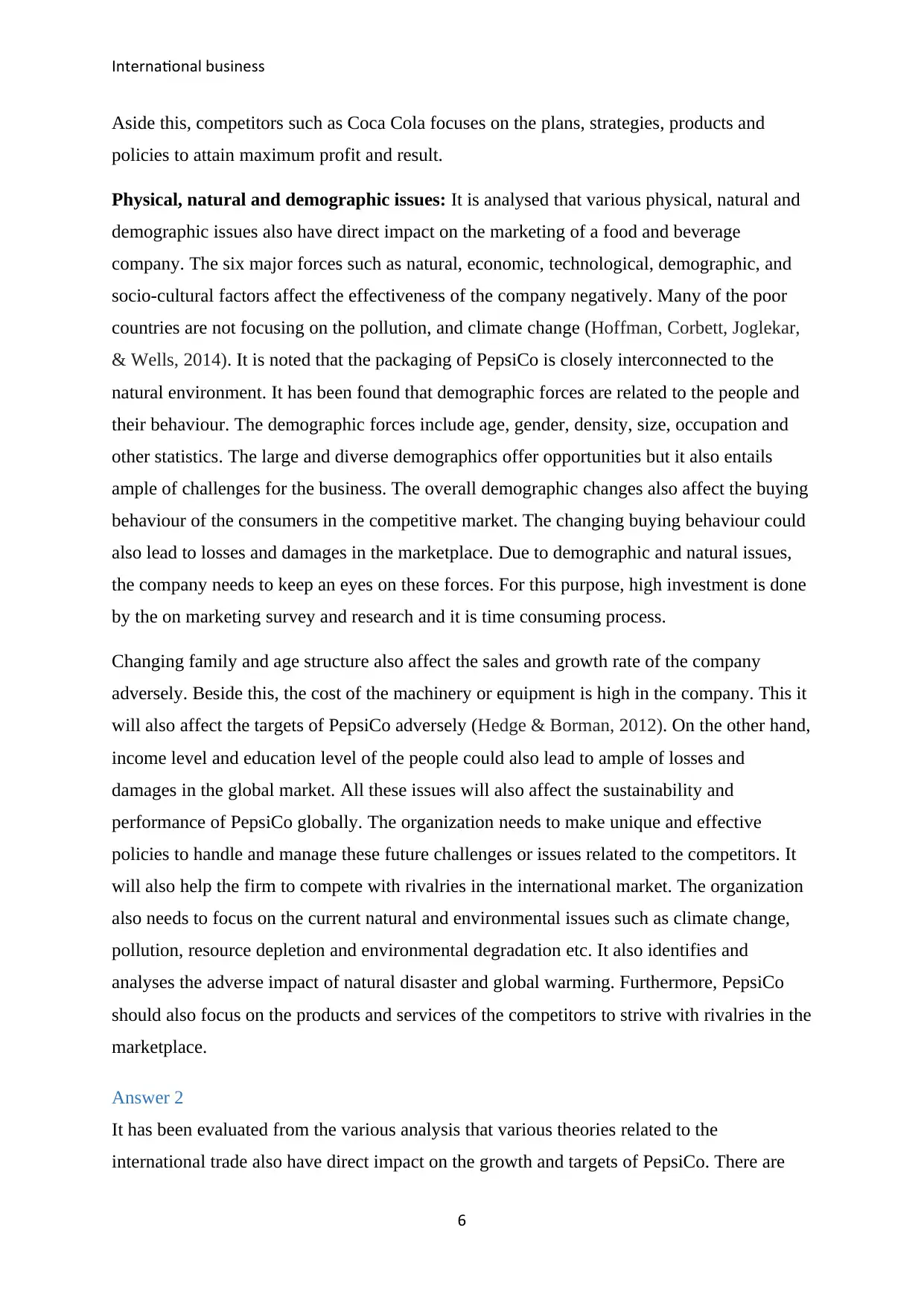
International business
Aside this, competitors such as Coca Cola focuses on the plans, strategies, products and
policies to attain maximum profit and result.
Physical, natural and demographic issues: It is analysed that various physical, natural and
demographic issues also have direct impact on the marketing of a food and beverage
company. The six major forces such as natural, economic, technological, demographic, and
socio-cultural factors affect the effectiveness of the company negatively. Many of the poor
countries are not focusing on the pollution, and climate change (Hoffman, Corbett, Joglekar,
& Wells, 2014). It is noted that the packaging of PepsiCo is closely interconnected to the
natural environment. It has been found that demographic forces are related to the people and
their behaviour. The demographic forces include age, gender, density, size, occupation and
other statistics. The large and diverse demographics offer opportunities but it also entails
ample of challenges for the business. The overall demographic changes also affect the buying
behaviour of the consumers in the competitive market. The changing buying behaviour could
also lead to losses and damages in the marketplace. Due to demographic and natural issues,
the company needs to keep an eyes on these forces. For this purpose, high investment is done
by the on marketing survey and research and it is time consuming process.
Changing family and age structure also affect the sales and growth rate of the company
adversely. Beside this, the cost of the machinery or equipment is high in the company. This it
will also affect the targets of PepsiCo adversely (Hedge & Borman, 2012). On the other hand,
income level and education level of the people could also lead to ample of losses and
damages in the global market. All these issues will also affect the sustainability and
performance of PepsiCo globally. The organization needs to make unique and effective
policies to handle and manage these future challenges or issues related to the competitors. It
will also help the firm to compete with rivalries in the international market. The organization
also needs to focus on the current natural and environmental issues such as climate change,
pollution, resource depletion and environmental degradation etc. It also identifies and
analyses the adverse impact of natural disaster and global warming. Furthermore, PepsiCo
should also focus on the products and services of the competitors to strive with rivalries in the
marketplace.
Answer 2
It has been evaluated from the various analysis that various theories related to the
international trade also have direct impact on the growth and targets of PepsiCo. There are
6
Aside this, competitors such as Coca Cola focuses on the plans, strategies, products and
policies to attain maximum profit and result.
Physical, natural and demographic issues: It is analysed that various physical, natural and
demographic issues also have direct impact on the marketing of a food and beverage
company. The six major forces such as natural, economic, technological, demographic, and
socio-cultural factors affect the effectiveness of the company negatively. Many of the poor
countries are not focusing on the pollution, and climate change (Hoffman, Corbett, Joglekar,
& Wells, 2014). It is noted that the packaging of PepsiCo is closely interconnected to the
natural environment. It has been found that demographic forces are related to the people and
their behaviour. The demographic forces include age, gender, density, size, occupation and
other statistics. The large and diverse demographics offer opportunities but it also entails
ample of challenges for the business. The overall demographic changes also affect the buying
behaviour of the consumers in the competitive market. The changing buying behaviour could
also lead to losses and damages in the marketplace. Due to demographic and natural issues,
the company needs to keep an eyes on these forces. For this purpose, high investment is done
by the on marketing survey and research and it is time consuming process.
Changing family and age structure also affect the sales and growth rate of the company
adversely. Beside this, the cost of the machinery or equipment is high in the company. This it
will also affect the targets of PepsiCo adversely (Hedge & Borman, 2012). On the other hand,
income level and education level of the people could also lead to ample of losses and
damages in the global market. All these issues will also affect the sustainability and
performance of PepsiCo globally. The organization needs to make unique and effective
policies to handle and manage these future challenges or issues related to the competitors. It
will also help the firm to compete with rivalries in the international market. The organization
also needs to focus on the current natural and environmental issues such as climate change,
pollution, resource depletion and environmental degradation etc. It also identifies and
analyses the adverse impact of natural disaster and global warming. Furthermore, PepsiCo
should also focus on the products and services of the competitors to strive with rivalries in the
marketplace.
Answer 2
It has been evaluated from the various analysis that various theories related to the
international trade also have direct impact on the growth and targets of PepsiCo. There are
6
⊘ This is a preview!⊘
Do you want full access?
Subscribe today to unlock all pages.

Trusted by 1+ million students worldwide
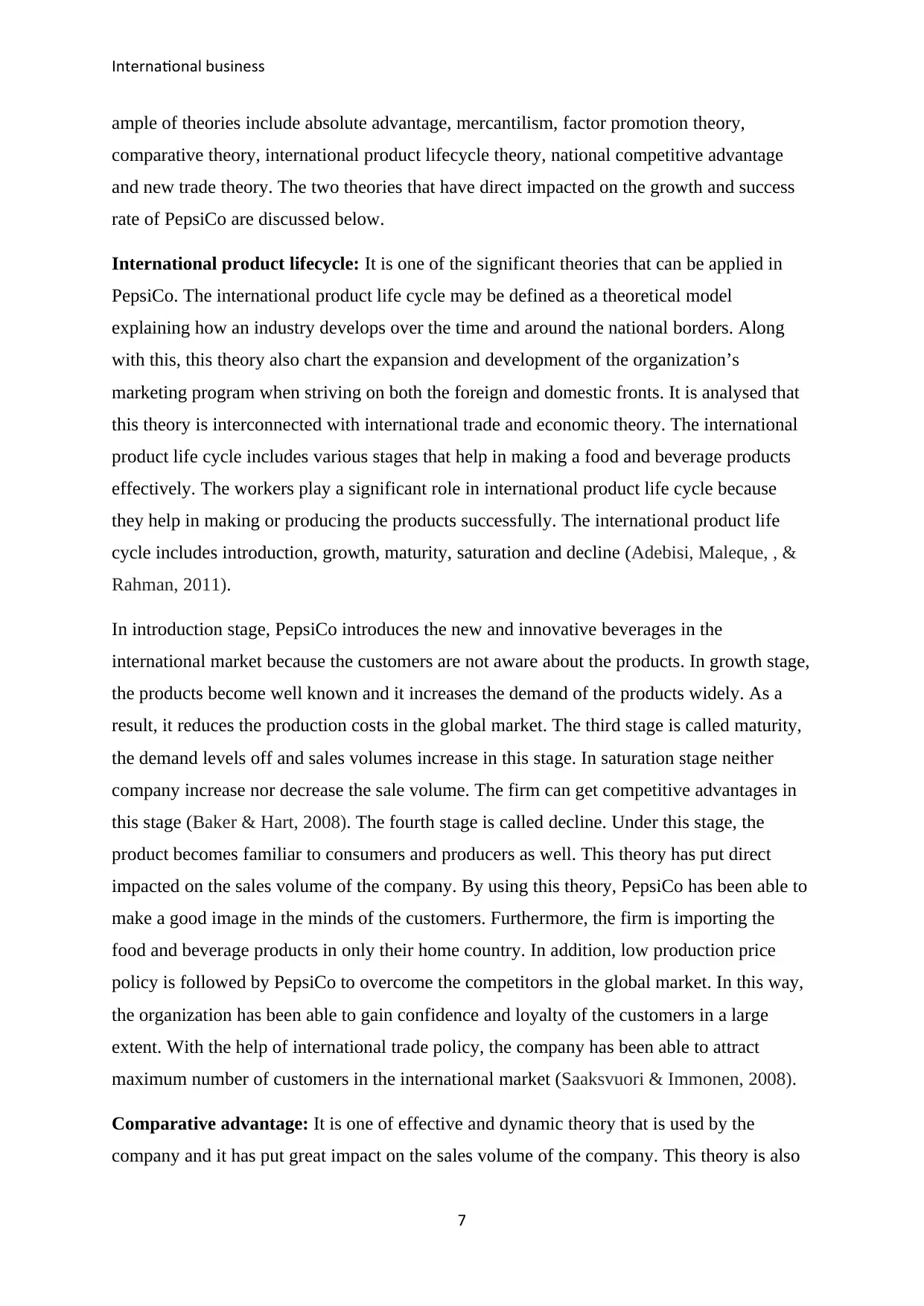
International business
ample of theories include absolute advantage, mercantilism, factor promotion theory,
comparative theory, international product lifecycle theory, national competitive advantage
and new trade theory. The two theories that have direct impacted on the growth and success
rate of PepsiCo are discussed below.
International product lifecycle: It is one of the significant theories that can be applied in
PepsiCo. The international product life cycle may be defined as a theoretical model
explaining how an industry develops over the time and around the national borders. Along
with this, this theory also chart the expansion and development of the organization’s
marketing program when striving on both the foreign and domestic fronts. It is analysed that
this theory is interconnected with international trade and economic theory. The international
product life cycle includes various stages that help in making a food and beverage products
effectively. The workers play a significant role in international product life cycle because
they help in making or producing the products successfully. The international product life
cycle includes introduction, growth, maturity, saturation and decline (Adebisi, Maleque, , &
Rahman, 2011).
In introduction stage, PepsiCo introduces the new and innovative beverages in the
international market because the customers are not aware about the products. In growth stage,
the products become well known and it increases the demand of the products widely. As a
result, it reduces the production costs in the global market. The third stage is called maturity,
the demand levels off and sales volumes increase in this stage. In saturation stage neither
company increase nor decrease the sale volume. The firm can get competitive advantages in
this stage (Baker & Hart, 2008). The fourth stage is called decline. Under this stage, the
product becomes familiar to consumers and producers as well. This theory has put direct
impacted on the sales volume of the company. By using this theory, PepsiCo has been able to
make a good image in the minds of the customers. Furthermore, the firm is importing the
food and beverage products in only their home country. In addition, low production price
policy is followed by PepsiCo to overcome the competitors in the global market. In this way,
the organization has been able to gain confidence and loyalty of the customers in a large
extent. With the help of international trade policy, the company has been able to attract
maximum number of customers in the international market (Saaksvuori & Immonen, 2008).
Comparative advantage: It is one of effective and dynamic theory that is used by the
company and it has put great impact on the sales volume of the company. This theory is also
7
ample of theories include absolute advantage, mercantilism, factor promotion theory,
comparative theory, international product lifecycle theory, national competitive advantage
and new trade theory. The two theories that have direct impacted on the growth and success
rate of PepsiCo are discussed below.
International product lifecycle: It is one of the significant theories that can be applied in
PepsiCo. The international product life cycle may be defined as a theoretical model
explaining how an industry develops over the time and around the national borders. Along
with this, this theory also chart the expansion and development of the organization’s
marketing program when striving on both the foreign and domestic fronts. It is analysed that
this theory is interconnected with international trade and economic theory. The international
product life cycle includes various stages that help in making a food and beverage products
effectively. The workers play a significant role in international product life cycle because
they help in making or producing the products successfully. The international product life
cycle includes introduction, growth, maturity, saturation and decline (Adebisi, Maleque, , &
Rahman, 2011).
In introduction stage, PepsiCo introduces the new and innovative beverages in the
international market because the customers are not aware about the products. In growth stage,
the products become well known and it increases the demand of the products widely. As a
result, it reduces the production costs in the global market. The third stage is called maturity,
the demand levels off and sales volumes increase in this stage. In saturation stage neither
company increase nor decrease the sale volume. The firm can get competitive advantages in
this stage (Baker & Hart, 2008). The fourth stage is called decline. Under this stage, the
product becomes familiar to consumers and producers as well. This theory has put direct
impacted on the sales volume of the company. By using this theory, PepsiCo has been able to
make a good image in the minds of the customers. Furthermore, the firm is importing the
food and beverage products in only their home country. In addition, low production price
policy is followed by PepsiCo to overcome the competitors in the global market. In this way,
the organization has been able to gain confidence and loyalty of the customers in a large
extent. With the help of international trade policy, the company has been able to attract
maximum number of customers in the international market (Saaksvuori & Immonen, 2008).
Comparative advantage: It is one of effective and dynamic theory that is used by the
company and it has put great impact on the sales volume of the company. This theory is also
7
Paraphrase This Document
Need a fresh take? Get an instant paraphrase of this document with our AI Paraphraser
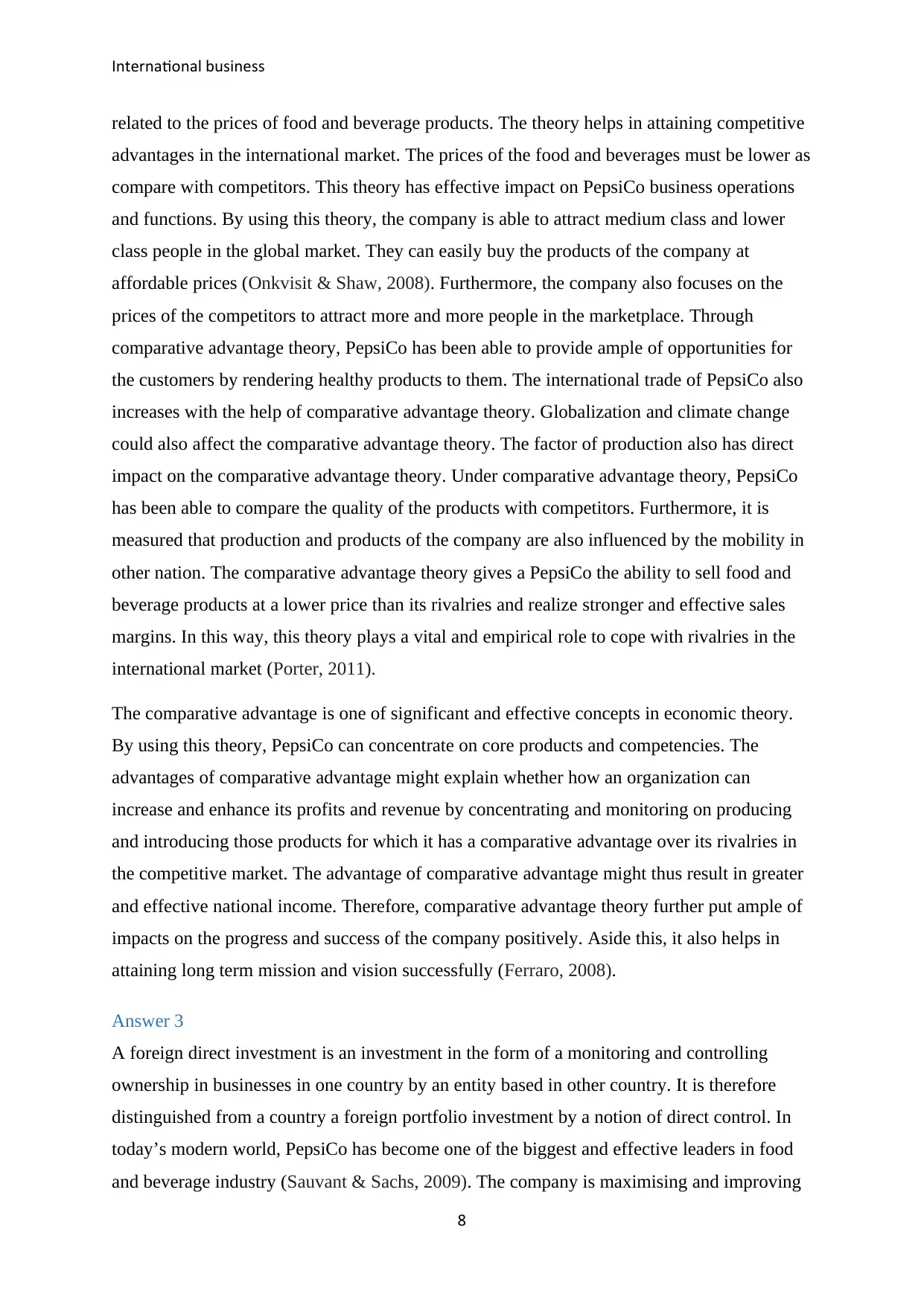
International business
related to the prices of food and beverage products. The theory helps in attaining competitive
advantages in the international market. The prices of the food and beverages must be lower as
compare with competitors. This theory has effective impact on PepsiCo business operations
and functions. By using this theory, the company is able to attract medium class and lower
class people in the global market. They can easily buy the products of the company at
affordable prices (Onkvisit & Shaw, 2008). Furthermore, the company also focuses on the
prices of the competitors to attract more and more people in the marketplace. Through
comparative advantage theory, PepsiCo has been able to provide ample of opportunities for
the customers by rendering healthy products to them. The international trade of PepsiCo also
increases with the help of comparative advantage theory. Globalization and climate change
could also affect the comparative advantage theory. The factor of production also has direct
impact on the comparative advantage theory. Under comparative advantage theory, PepsiCo
has been able to compare the quality of the products with competitors. Furthermore, it is
measured that production and products of the company are also influenced by the mobility in
other nation. The comparative advantage theory gives a PepsiCo the ability to sell food and
beverage products at a lower price than its rivalries and realize stronger and effective sales
margins. In this way, this theory plays a vital and empirical role to cope with rivalries in the
international market (Porter, 2011).
The comparative advantage is one of significant and effective concepts in economic theory.
By using this theory, PepsiCo can concentrate on core products and competencies. The
advantages of comparative advantage might explain whether how an organization can
increase and enhance its profits and revenue by concentrating and monitoring on producing
and introducing those products for which it has a comparative advantage over its rivalries in
the competitive market. The advantage of comparative advantage might thus result in greater
and effective national income. Therefore, comparative advantage theory further put ample of
impacts on the progress and success of the company positively. Aside this, it also helps in
attaining long term mission and vision successfully (Ferraro, 2008).
Answer 3
A foreign direct investment is an investment in the form of a monitoring and controlling
ownership in businesses in one country by an entity based in other country. It is therefore
distinguished from a country a foreign portfolio investment by a notion of direct control. In
today’s modern world, PepsiCo has become one of the biggest and effective leaders in food
and beverage industry (Sauvant & Sachs, 2009). The company is maximising and improving
8
related to the prices of food and beverage products. The theory helps in attaining competitive
advantages in the international market. The prices of the food and beverages must be lower as
compare with competitors. This theory has effective impact on PepsiCo business operations
and functions. By using this theory, the company is able to attract medium class and lower
class people in the global market. They can easily buy the products of the company at
affordable prices (Onkvisit & Shaw, 2008). Furthermore, the company also focuses on the
prices of the competitors to attract more and more people in the marketplace. Through
comparative advantage theory, PepsiCo has been able to provide ample of opportunities for
the customers by rendering healthy products to them. The international trade of PepsiCo also
increases with the help of comparative advantage theory. Globalization and climate change
could also affect the comparative advantage theory. The factor of production also has direct
impact on the comparative advantage theory. Under comparative advantage theory, PepsiCo
has been able to compare the quality of the products with competitors. Furthermore, it is
measured that production and products of the company are also influenced by the mobility in
other nation. The comparative advantage theory gives a PepsiCo the ability to sell food and
beverage products at a lower price than its rivalries and realize stronger and effective sales
margins. In this way, this theory plays a vital and empirical role to cope with rivalries in the
international market (Porter, 2011).
The comparative advantage is one of significant and effective concepts in economic theory.
By using this theory, PepsiCo can concentrate on core products and competencies. The
advantages of comparative advantage might explain whether how an organization can
increase and enhance its profits and revenue by concentrating and monitoring on producing
and introducing those products for which it has a comparative advantage over its rivalries in
the competitive market. The advantage of comparative advantage might thus result in greater
and effective national income. Therefore, comparative advantage theory further put ample of
impacts on the progress and success of the company positively. Aside this, it also helps in
attaining long term mission and vision successfully (Ferraro, 2008).
Answer 3
A foreign direct investment is an investment in the form of a monitoring and controlling
ownership in businesses in one country by an entity based in other country. It is therefore
distinguished from a country a foreign portfolio investment by a notion of direct control. In
today’s modern world, PepsiCo has become one of the biggest and effective leaders in food
and beverage industry (Sauvant & Sachs, 2009). The company is maximising and improving
8
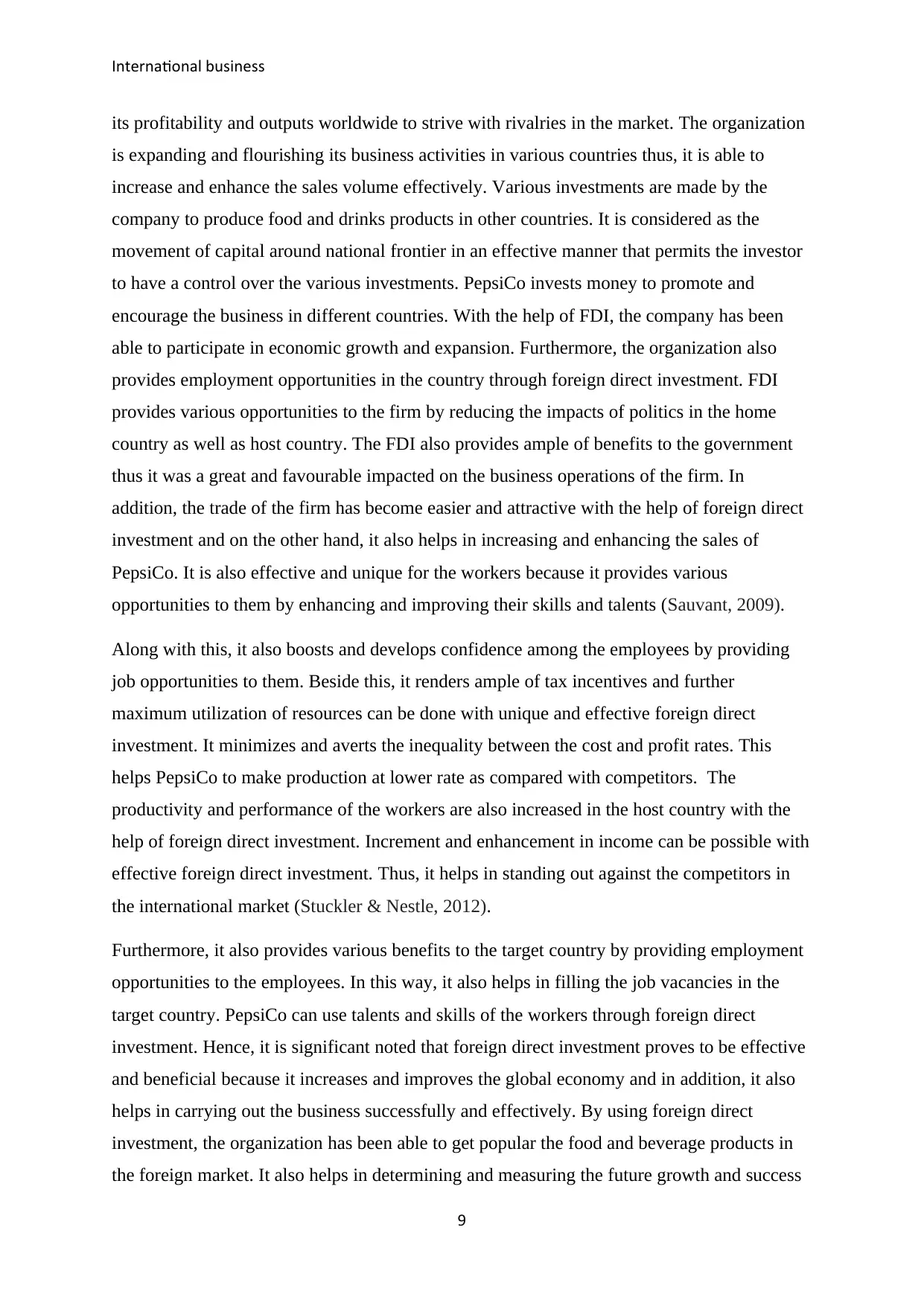
International business
its profitability and outputs worldwide to strive with rivalries in the market. The organization
is expanding and flourishing its business activities in various countries thus, it is able to
increase and enhance the sales volume effectively. Various investments are made by the
company to produce food and drinks products in other countries. It is considered as the
movement of capital around national frontier in an effective manner that permits the investor
to have a control over the various investments. PepsiCo invests money to promote and
encourage the business in different countries. With the help of FDI, the company has been
able to participate in economic growth and expansion. Furthermore, the organization also
provides employment opportunities in the country through foreign direct investment. FDI
provides various opportunities to the firm by reducing the impacts of politics in the home
country as well as host country. The FDI also provides ample of benefits to the government
thus it was a great and favourable impacted on the business operations of the firm. In
addition, the trade of the firm has become easier and attractive with the help of foreign direct
investment and on the other hand, it also helps in increasing and enhancing the sales of
PepsiCo. It is also effective and unique for the workers because it provides various
opportunities to them by enhancing and improving their skills and talents (Sauvant, 2009).
Along with this, it also boosts and develops confidence among the employees by providing
job opportunities to them. Beside this, it renders ample of tax incentives and further
maximum utilization of resources can be done with unique and effective foreign direct
investment. It minimizes and averts the inequality between the cost and profit rates. This
helps PepsiCo to make production at lower rate as compared with competitors. The
productivity and performance of the workers are also increased in the host country with the
help of foreign direct investment. Increment and enhancement in income can be possible with
effective foreign direct investment. Thus, it helps in standing out against the competitors in
the international market (Stuckler & Nestle, 2012).
Furthermore, it also provides various benefits to the target country by providing employment
opportunities to the employees. In this way, it also helps in filling the job vacancies in the
target country. PepsiCo can use talents and skills of the workers through foreign direct
investment. Hence, it is significant noted that foreign direct investment proves to be effective
and beneficial because it increases and improves the global economy and in addition, it also
helps in carrying out the business successfully and effectively. By using foreign direct
investment, the organization has been able to get popular the food and beverage products in
the foreign market. It also helps in determining and measuring the future growth and success
9
its profitability and outputs worldwide to strive with rivalries in the market. The organization
is expanding and flourishing its business activities in various countries thus, it is able to
increase and enhance the sales volume effectively. Various investments are made by the
company to produce food and drinks products in other countries. It is considered as the
movement of capital around national frontier in an effective manner that permits the investor
to have a control over the various investments. PepsiCo invests money to promote and
encourage the business in different countries. With the help of FDI, the company has been
able to participate in economic growth and expansion. Furthermore, the organization also
provides employment opportunities in the country through foreign direct investment. FDI
provides various opportunities to the firm by reducing the impacts of politics in the home
country as well as host country. The FDI also provides ample of benefits to the government
thus it was a great and favourable impacted on the business operations of the firm. In
addition, the trade of the firm has become easier and attractive with the help of foreign direct
investment and on the other hand, it also helps in increasing and enhancing the sales of
PepsiCo. It is also effective and unique for the workers because it provides various
opportunities to them by enhancing and improving their skills and talents (Sauvant, 2009).
Along with this, it also boosts and develops confidence among the employees by providing
job opportunities to them. Beside this, it renders ample of tax incentives and further
maximum utilization of resources can be done with unique and effective foreign direct
investment. It minimizes and averts the inequality between the cost and profit rates. This
helps PepsiCo to make production at lower rate as compared with competitors. The
productivity and performance of the workers are also increased in the host country with the
help of foreign direct investment. Increment and enhancement in income can be possible with
effective foreign direct investment. Thus, it helps in standing out against the competitors in
the international market (Stuckler & Nestle, 2012).
Furthermore, it also provides various benefits to the target country by providing employment
opportunities to the employees. In this way, it also helps in filling the job vacancies in the
target country. PepsiCo can use talents and skills of the workers through foreign direct
investment. Hence, it is significant noted that foreign direct investment proves to be effective
and beneficial because it increases and improves the global economy and in addition, it also
helps in carrying out the business successfully and effectively. By using foreign direct
investment, the organization has been able to get popular the food and beverage products in
the foreign market. It also helps in determining and measuring the future growth and success
9
⊘ This is a preview!⊘
Do you want full access?
Subscribe today to unlock all pages.

Trusted by 1+ million students worldwide
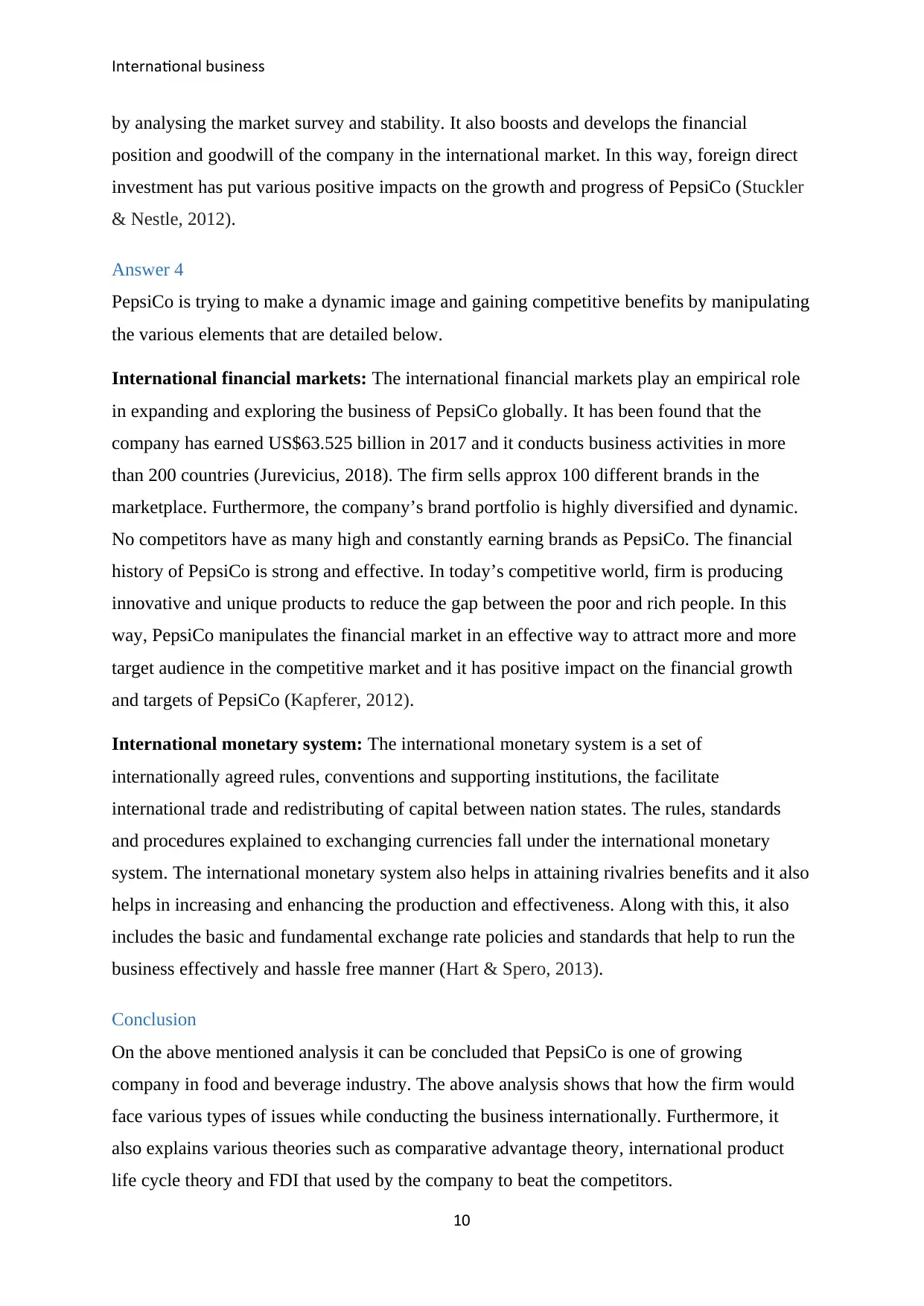
International business
by analysing the market survey and stability. It also boosts and develops the financial
position and goodwill of the company in the international market. In this way, foreign direct
investment has put various positive impacts on the growth and progress of PepsiCo (Stuckler
& Nestle, 2012).
Answer 4
PepsiCo is trying to make a dynamic image and gaining competitive benefits by manipulating
the various elements that are detailed below.
International financial markets: The international financial markets play an empirical role
in expanding and exploring the business of PepsiCo globally. It has been found that the
company has earned US$63.525 billion in 2017 and it conducts business activities in more
than 200 countries (Jurevicius, 2018). The firm sells approx 100 different brands in the
marketplace. Furthermore, the company’s brand portfolio is highly diversified and dynamic.
No competitors have as many high and constantly earning brands as PepsiCo. The financial
history of PepsiCo is strong and effective. In today’s competitive world, firm is producing
innovative and unique products to reduce the gap between the poor and rich people. In this
way, PepsiCo manipulates the financial market in an effective way to attract more and more
target audience in the competitive market and it has positive impact on the financial growth
and targets of PepsiCo (Kapferer, 2012).
International monetary system: The international monetary system is a set of
internationally agreed rules, conventions and supporting institutions, the facilitate
international trade and redistributing of capital between nation states. The rules, standards
and procedures explained to exchanging currencies fall under the international monetary
system. The international monetary system also helps in attaining rivalries benefits and it also
helps in increasing and enhancing the production and effectiveness. Along with this, it also
includes the basic and fundamental exchange rate policies and standards that help to run the
business effectively and hassle free manner (Hart & Spero, 2013).
Conclusion
On the above mentioned analysis it can be concluded that PepsiCo is one of growing
company in food and beverage industry. The above analysis shows that how the firm would
face various types of issues while conducting the business internationally. Furthermore, it
also explains various theories such as comparative advantage theory, international product
life cycle theory and FDI that used by the company to beat the competitors.
10
by analysing the market survey and stability. It also boosts and develops the financial
position and goodwill of the company in the international market. In this way, foreign direct
investment has put various positive impacts on the growth and progress of PepsiCo (Stuckler
& Nestle, 2012).
Answer 4
PepsiCo is trying to make a dynamic image and gaining competitive benefits by manipulating
the various elements that are detailed below.
International financial markets: The international financial markets play an empirical role
in expanding and exploring the business of PepsiCo globally. It has been found that the
company has earned US$63.525 billion in 2017 and it conducts business activities in more
than 200 countries (Jurevicius, 2018). The firm sells approx 100 different brands in the
marketplace. Furthermore, the company’s brand portfolio is highly diversified and dynamic.
No competitors have as many high and constantly earning brands as PepsiCo. The financial
history of PepsiCo is strong and effective. In today’s competitive world, firm is producing
innovative and unique products to reduce the gap between the poor and rich people. In this
way, PepsiCo manipulates the financial market in an effective way to attract more and more
target audience in the competitive market and it has positive impact on the financial growth
and targets of PepsiCo (Kapferer, 2012).
International monetary system: The international monetary system is a set of
internationally agreed rules, conventions and supporting institutions, the facilitate
international trade and redistributing of capital between nation states. The rules, standards
and procedures explained to exchanging currencies fall under the international monetary
system. The international monetary system also helps in attaining rivalries benefits and it also
helps in increasing and enhancing the production and effectiveness. Along with this, it also
includes the basic and fundamental exchange rate policies and standards that help to run the
business effectively and hassle free manner (Hart & Spero, 2013).
Conclusion
On the above mentioned analysis it can be concluded that PepsiCo is one of growing
company in food and beverage industry. The above analysis shows that how the firm would
face various types of issues while conducting the business internationally. Furthermore, it
also explains various theories such as comparative advantage theory, international product
life cycle theory and FDI that used by the company to beat the competitors.
10
Paraphrase This Document
Need a fresh take? Get an instant paraphrase of this document with our AI Paraphraser
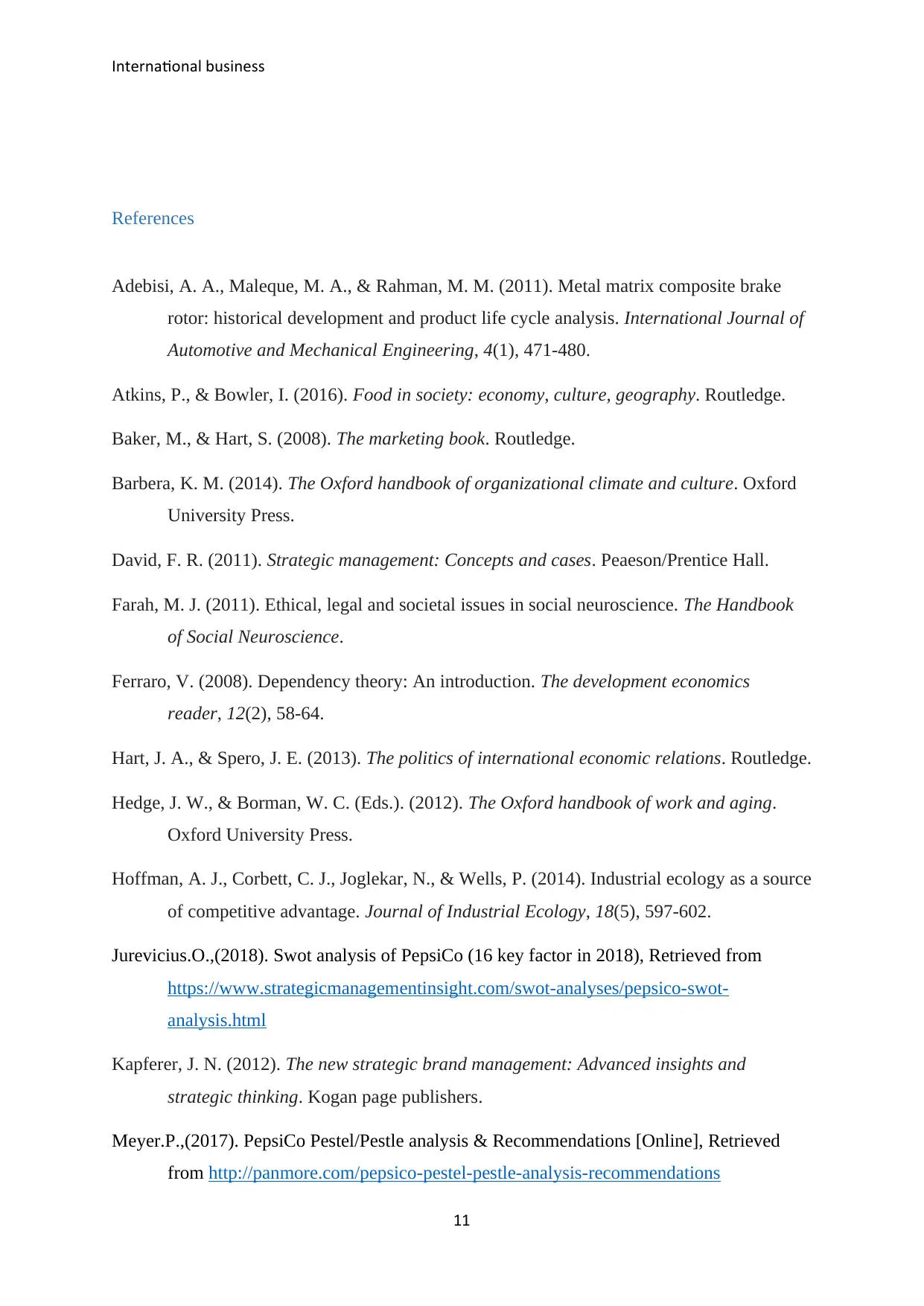
International business
References
Adebisi, A. A., Maleque, M. A., & Rahman, M. M. (2011). Metal matrix composite brake
rotor: historical development and product life cycle analysis. International Journal of
Automotive and Mechanical Engineering, 4(1), 471-480.
Atkins, P., & Bowler, I. (2016). Food in society: economy, culture, geography. Routledge.
Baker, M., & Hart, S. (2008). The marketing book. Routledge.
Barbera, K. M. (2014). The Oxford handbook of organizational climate and culture. Oxford
University Press.
David, F. R. (2011). Strategic management: Concepts and cases. Peaeson/Prentice Hall.
Farah, M. J. (2011). Ethical, legal and societal issues in social neuroscience. The Handbook
of Social Neuroscience.
Ferraro, V. (2008). Dependency theory: An introduction. The development economics
reader, 12(2), 58-64.
Hart, J. A., & Spero, J. E. (2013). The politics of international economic relations. Routledge.
Hedge, J. W., & Borman, W. C. (Eds.). (2012). The Oxford handbook of work and aging.
Oxford University Press.
Hoffman, A. J., Corbett, C. J., Joglekar, N., & Wells, P. (2014). Industrial ecology as a source
of competitive advantage. Journal of Industrial Ecology, 18(5), 597-602.
Jurevicius.O.,(2018). Swot analysis of PepsiCo (16 key factor in 2018), Retrieved from
https://www.strategicmanagementinsight.com/swot-analyses/pepsico-swot-
analysis.html
Kapferer, J. N. (2012). The new strategic brand management: Advanced insights and
strategic thinking. Kogan page publishers.
Meyer.P.,(2017). PepsiCo Pestel/Pestle analysis & Recommendations [Online], Retrieved
from http://panmore.com/pepsico-pestel-pestle-analysis-recommendations
11
References
Adebisi, A. A., Maleque, M. A., & Rahman, M. M. (2011). Metal matrix composite brake
rotor: historical development and product life cycle analysis. International Journal of
Automotive and Mechanical Engineering, 4(1), 471-480.
Atkins, P., & Bowler, I. (2016). Food in society: economy, culture, geography. Routledge.
Baker, M., & Hart, S. (2008). The marketing book. Routledge.
Barbera, K. M. (2014). The Oxford handbook of organizational climate and culture. Oxford
University Press.
David, F. R. (2011). Strategic management: Concepts and cases. Peaeson/Prentice Hall.
Farah, M. J. (2011). Ethical, legal and societal issues in social neuroscience. The Handbook
of Social Neuroscience.
Ferraro, V. (2008). Dependency theory: An introduction. The development economics
reader, 12(2), 58-64.
Hart, J. A., & Spero, J. E. (2013). The politics of international economic relations. Routledge.
Hedge, J. W., & Borman, W. C. (Eds.). (2012). The Oxford handbook of work and aging.
Oxford University Press.
Hoffman, A. J., Corbett, C. J., Joglekar, N., & Wells, P. (2014). Industrial ecology as a source
of competitive advantage. Journal of Industrial Ecology, 18(5), 597-602.
Jurevicius.O.,(2018). Swot analysis of PepsiCo (16 key factor in 2018), Retrieved from
https://www.strategicmanagementinsight.com/swot-analyses/pepsico-swot-
analysis.html
Kapferer, J. N. (2012). The new strategic brand management: Advanced insights and
strategic thinking. Kogan page publishers.
Meyer.P.,(2017). PepsiCo Pestel/Pestle analysis & Recommendations [Online], Retrieved
from http://panmore.com/pepsico-pestel-pestle-analysis-recommendations
11
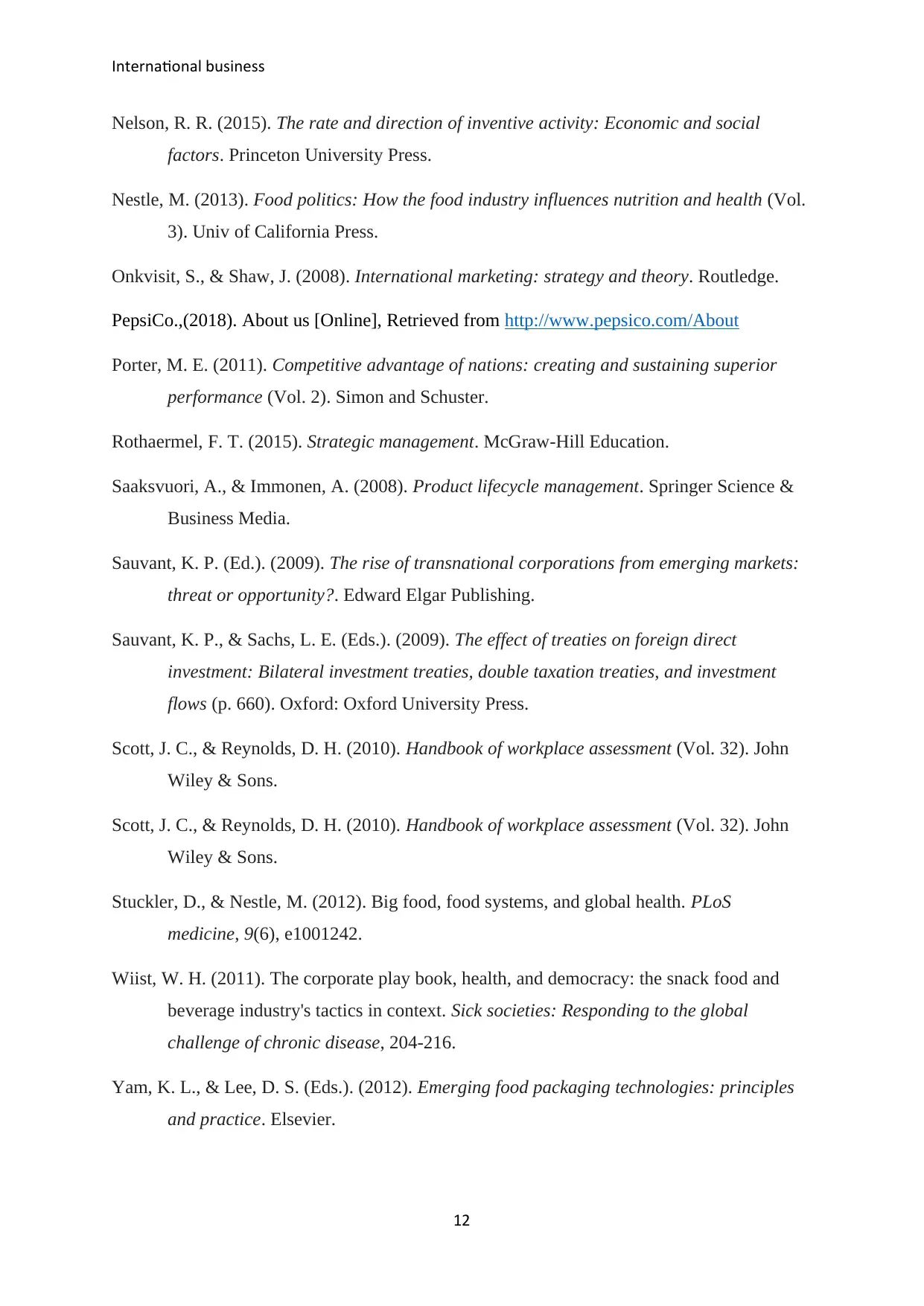
International business
Nelson, R. R. (2015). The rate and direction of inventive activity: Economic and social
factors. Princeton University Press.
Nestle, M. (2013). Food politics: How the food industry influences nutrition and health (Vol.
3). Univ of California Press.
Onkvisit, S., & Shaw, J. (2008). International marketing: strategy and theory. Routledge.
PepsiCo.,(2018). About us [Online], Retrieved from http://www.pepsico.com/About
Porter, M. E. (2011). Competitive advantage of nations: creating and sustaining superior
performance (Vol. 2). Simon and Schuster.
Rothaermel, F. T. (2015). Strategic management. McGraw-Hill Education.
Saaksvuori, A., & Immonen, A. (2008). Product lifecycle management. Springer Science &
Business Media.
Sauvant, K. P. (Ed.). (2009). The rise of transnational corporations from emerging markets:
threat or opportunity?. Edward Elgar Publishing.
Sauvant, K. P., & Sachs, L. E. (Eds.). (2009). The effect of treaties on foreign direct
investment: Bilateral investment treaties, double taxation treaties, and investment
flows (p. 660). Oxford: Oxford University Press.
Scott, J. C., & Reynolds, D. H. (2010). Handbook of workplace assessment (Vol. 32). John
Wiley & Sons.
Scott, J. C., & Reynolds, D. H. (2010). Handbook of workplace assessment (Vol. 32). John
Wiley & Sons.
Stuckler, D., & Nestle, M. (2012). Big food, food systems, and global health. PLoS
medicine, 9(6), e1001242.
Wiist, W. H. (2011). The corporate play book, health, and democracy: the snack food and
beverage industry's tactics in context. Sick societies: Responding to the global
challenge of chronic disease, 204-216.
Yam, K. L., & Lee, D. S. (Eds.). (2012). Emerging food packaging technologies: principles
and practice. Elsevier.
12
Nelson, R. R. (2015). The rate and direction of inventive activity: Economic and social
factors. Princeton University Press.
Nestle, M. (2013). Food politics: How the food industry influences nutrition and health (Vol.
3). Univ of California Press.
Onkvisit, S., & Shaw, J. (2008). International marketing: strategy and theory. Routledge.
PepsiCo.,(2018). About us [Online], Retrieved from http://www.pepsico.com/About
Porter, M. E. (2011). Competitive advantage of nations: creating and sustaining superior
performance (Vol. 2). Simon and Schuster.
Rothaermel, F. T. (2015). Strategic management. McGraw-Hill Education.
Saaksvuori, A., & Immonen, A. (2008). Product lifecycle management. Springer Science &
Business Media.
Sauvant, K. P. (Ed.). (2009). The rise of transnational corporations from emerging markets:
threat or opportunity?. Edward Elgar Publishing.
Sauvant, K. P., & Sachs, L. E. (Eds.). (2009). The effect of treaties on foreign direct
investment: Bilateral investment treaties, double taxation treaties, and investment
flows (p. 660). Oxford: Oxford University Press.
Scott, J. C., & Reynolds, D. H. (2010). Handbook of workplace assessment (Vol. 32). John
Wiley & Sons.
Scott, J. C., & Reynolds, D. H. (2010). Handbook of workplace assessment (Vol. 32). John
Wiley & Sons.
Stuckler, D., & Nestle, M. (2012). Big food, food systems, and global health. PLoS
medicine, 9(6), e1001242.
Wiist, W. H. (2011). The corporate play book, health, and democracy: the snack food and
beverage industry's tactics in context. Sick societies: Responding to the global
challenge of chronic disease, 204-216.
Yam, K. L., & Lee, D. S. (Eds.). (2012). Emerging food packaging technologies: principles
and practice. Elsevier.
12
⊘ This is a preview!⊘
Do you want full access?
Subscribe today to unlock all pages.

Trusted by 1+ million students worldwide
1 out of 12
Related Documents
Your All-in-One AI-Powered Toolkit for Academic Success.
+13062052269
info@desklib.com
Available 24*7 on WhatsApp / Email
![[object Object]](/_next/static/media/star-bottom.7253800d.svg)
Unlock your academic potential
Copyright © 2020–2025 A2Z Services. All Rights Reserved. Developed and managed by ZUCOL.





